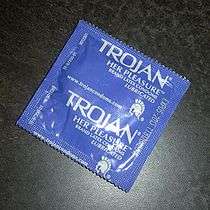Trojan (brand)
|
| |
 | |
| Owner | Church & Dwight Company |
|---|---|
| Country | United States |
| Introduced | 1916 |
| Previous owners |
Fay and Youngs (1916) Youngs Drug Products (1919) Carter-Wallace (1985) Church & Dwight (2001) |
| Tagline | Trojan. Pleasure you want. Protection you trust. |
| Website | trojancondoms.com |
Trojan is a brand name of condoms and sexual lubricants manufactured by the Church & Dwight Company. As of 2006, 69 percent of condoms purchased in United States drugstores are Trojan brand.[1] Trojan condoms were the idea of an enterprising Presbyterian from upstate New York named Merle Leland Youngs. When Youngs moved to New York City in the 1910s, the major condom manufacturer was Julius Schmid, who made Ramses and other reliable brands as early as the 1880s.[2] Other elements of the condom trade were run by seedy, fly-by-night manufacturers selling cheap wares.
Due to the Comstock Law of 1873 and many similar state laws, condoms were until 1957 sold as protection against disease. Still, many pharmacists were loath to stock a product associated with sexual vice. For that reason, consumers often had to purchase their condoms in the backrooms of bars.
Brand history
Trojan condoms were first manufactured in 1916 by Merle Leland Youngs through his company Fay and Youngs, renamed Youngs Rubber Corporation in 1919. Youngs Rubber Corporation debuted Trojan brand condoms with the image of the Trojan helmet.[3] Trojan began advertising condoms in 1927 through an ad placed in a trade magazine for pharmacists.[4]
By 1930 latex-based materials were used. Latex was less expensive than the rubber used previously, while still providing protection against disease and pregnancy. The material change also allowed a shelf life of five years in comparison to three months.[5] Like all condoms sold in the U.S., Trojan condoms are electrically tested for durability and reliability. As of 2009, Trojan produces 30 different varieties of condoms.[6]
Research
Since 2006, Trojan has conducted the Sexual Health Report Card, an annual ranking of the sexual health resources available to students at college and university campuses throughout the United States. Student health centers at 141 schools from the various Bowl Championship Series conferences are ranked on the students' opinion of subjects such as their health center, condom and other contraceptive availability, HIV and STD testing, student peer groups, sexual assault programs and resources, and website usability.[7][8][9] Research firm Sperling's BestPlaces collates and analyzes the data.
Marketing
In 2003, in order to introduce Trojan condoms in the United Kingdom, a humorous fake official web site for the so-called Trojan Games was created. The Trojan Games were supposedly an international sporting event similar to the Olympics and taking place in Bucharest. The sports were based on sexual performance. As of November 2006 the various "Trojan Games" videos had been viewed 300 million times.[10] Trojan Vibrations gave away a total of 7,000 free vibrators in New York City and Washington, DC in 2012.[11][12]
References
- ↑ Koerner, Brendan (29 September 2006). "The Other Trojan War – What's the best-selling condom in America?". Slate. Archived from the original on 9 January 2012.
- ↑ Tone, Andrea (2002). Devices and Desires: A History of Contraceptives in America. New York: Hill and Wang. p. 50. ISBN 0-8090-3816-1.
- ↑ Tone, Andrea (2002). Devices and Desires: A History of Contraceptives in America. New York: Hill and Wang. p. 188. ISBN 0-8090-3816-1.
- ↑ Newman, Andrew Adam (18 June 2007). "Pigs With Cellphones, but No Condoms". The New York Times. Retrieved 28 April 2009.
The 87-year-old company placed its first ad in trade magazines for pharmacists in 1927, when druggists still kept condoms behind the counter. Though out in the aisles for decades, condoms are still purchased furtively: while the average time shopping for a home-pregnancy test is 2.5 minutes, the average condom buyer takes just 7 seconds, according to research by Trojan. “We call it a drive-by purchase,” Mr. Daniels said. 'People to this day are embarrassed.'
- ↑ Collier, Aine (2007). The Humble Little Condom: A History. Buffalo, N.Y: Prometheus Books.
- ↑ "About Trojan Condoms". Church & Dwight Co., Inc. Retrieved 28 April 2009.
- ↑ "University of Illinois Dethrones Columbia University to Take Top Spot in the 2012 Trojan Sexual Health Report Card" (Press release). Trojan Condoms. 23 October 2012. Retrieved 21 December 2012 – via PR Newswire.
- ↑ "2011 Sexual Health Report Card" (PDF). Trojan Condoms. Retrieved 21 December 2012.
- ↑ Rosenbloom, Stephanie (24 September 2006). "Here's Your Syllabus, and Your Condom". The New York Times. Retrieved 21 December 2012.
- ↑ Lucas, Dean (4 March 2007). "Trojan Games". Famous Pictures. Retrieved 21 July 2007.
- ↑ Wetherbee, Brandon (13 November 2012). "Trojan Vibrator Giveaway In D.C. Distributes 3,000 Free Sex Toys (PHOTOS)". The Huffington Post. Retrieved 25 February 2014.
- ↑ "Trojan Vibrator Giveaway Ok'd In New York: 4,000 Vibrators Handed Out In Meatpacking District (PHOTOS)". The Huffington Post. 10 August 2012. Retrieved 25 February 2014.